Snow-shoo cats: description, color variations and features of the content
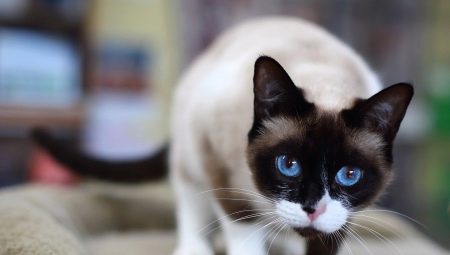
Snow-shu belong to the aristocratic breed of cats. Possessing grace and spectacular appearance, individuals of this breed managed to fall in love with many. It is worth familiarizing yourself with the description of pedigree cats, the peculiarities of their color, habits and nuances of the content.
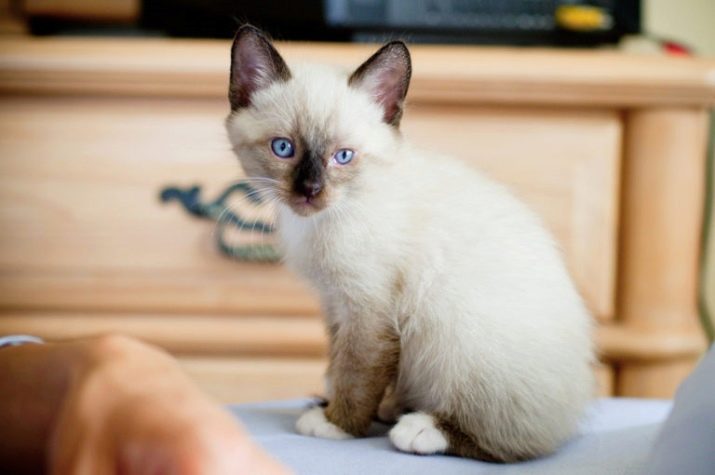
Description
Snow shoo is a cat of a special breed, bred by breeders. Translated, its name means "snow shoe", which is why individuals of the breed are often called "little white feet". The appearance of these cats deserves special attention: they resemble beautiful plush toys, while the weight of individuals can reach 7 kg. No breeder will tell you how a kitten will be born, as its color can turn out to be unpredictable. A distinctive feature of the appearance of a snow shoo is the presence of white paws or so-called socks. The paws of the representatives of the breed are long, the body is massive, correctly proportioned and muscular, the coat is short.
The following traits are considered breed standards:
- wedge-shaped head with high cheekbones and rounded contours;
- the average body weight, as a rule, in females does not exceed 4–5 kg;
- medium-sized wide-set ears with rounded edges;
- developed limbs and a tail of medium length, tapering towards the end;
- silky coat and large beautiful eyes of blue or bluish tint;
- a smooth bend or a slight hump on the bridge of the nose.
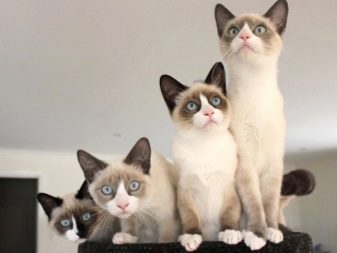

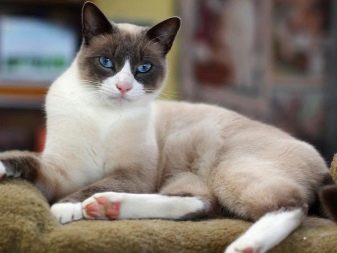
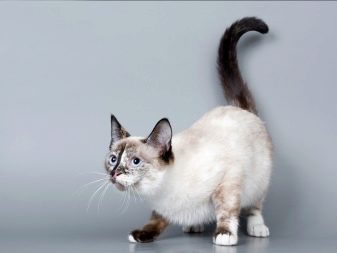
Outwardly, this cat looks like the representatives of the Siamese breed. This similarity is no coincidence: the snow-shoo is a relative of the Siamese cat, despite the fact that it has its own differences in exterior and character. The head of this cat is the same in length and width, the forehead is flat.The shape of the eyes can be different: oval, rounded, inclined towards the base of the ears. They are not performing.
The chin of the snow-shou is strong, the muzzle is proportional, the length of the neck is medium. The body of a plush cat is moderately long, powerful and flexible. The backbone is medium, the musculature is well developed. The skin of the nose and paws of a snow shoo can be mottled or colored to match the skin tone.
Individuals with a thin tail, long hair (long-haired), fragile constitution and without white legs are not classified as a purebred breed. A purebred cat has no undercoat, which explains the smoothness of its coat.
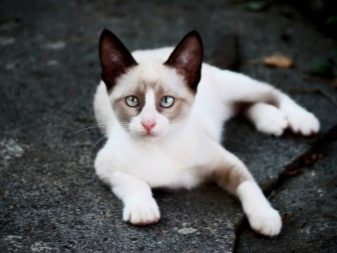
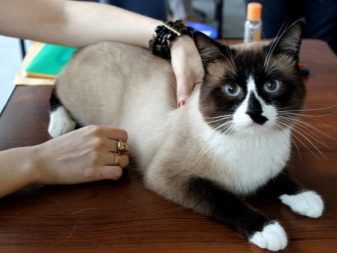
Life span
On average, the lifespan of a snow shoo can range from 10 to 12 years. Some individuals live for about 15-16 years. The lifespan may depend on various factors. This is the calmness of the pet, its timely examination, vaccination, walks in the fresh air, absence of diseases and proper nutrition.
However, in addition to the quality of care and care, this may also depend on the heredity of the pet and its living conditions.
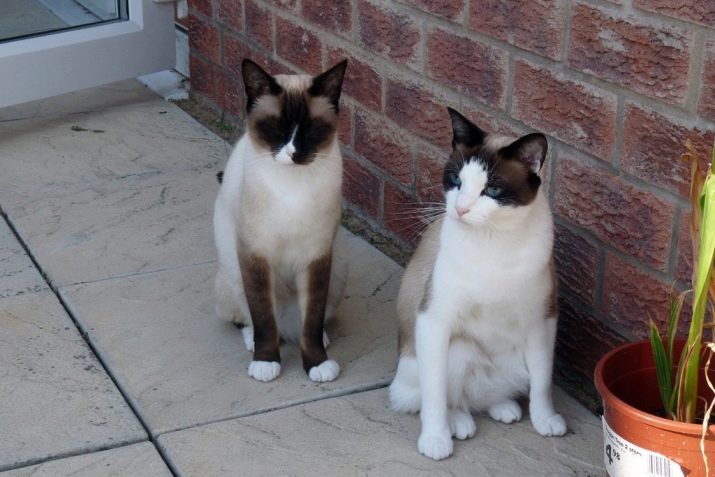
Color options
Usually, the color of the snow-sho cat resembles the coat of a Siamese cat, although it also has its own characteristics. For example, socks on paws, covered with snow-white wool, differ in length. On the hind legs, it goes to the ankles, on the front - to the wrists. A characteristic feature of the color is its richness.
Conditionally color type can be divided into two categories: blue point and seal point... In the first case, the marks have a gray-blue tint, in the second, their palette may include shades from beige to brown. Whatever the basic shade of the fur coat, the hair on the ears, tail and muzzle should be dark, on the belly and chest it is the lightest.
Kittens of this breed are born white, it is impossible to say unequivocally what the color of a particular individual will be. The final color is established when the cat turns 2 years old. The cat can be colored in different ways. For example, it can be a bicolor variant or a two-tone color with a predominance of white. In such individuals, dark spots can be of different sizes, but at the same time they are located mainly in the upper body and do not join together. The tortoiseshell color is rather rare, with it spots of three shades cover most of the body of the individual. As for the white coat, it appears on the muzzle as a tick and a stripe across the chin.
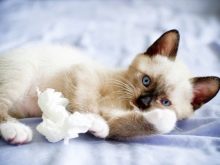

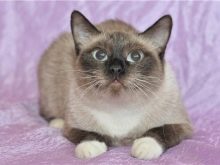
Character traits
Representatives of the breed "cats in snow socks" can have a different character, which depends on the correct upbringing of pets, which are engaged from their first months of life. In general, these cats are quite peaceful and moderately affectionate, which makes them different from their Siamese counterparts. "Snow White" are often docile, loyal, have a cheerful disposition, and sometimes talkativeness. They love their owners and cannot stand long separation from them. During their life, they become attached to the owner and feel his emotional state by the tone of his voice, while the pet can quickly adapt to the desired mood. For example, he is able to play with the owner, if he is inclined to do so. In addition, the pet can "regret" in its own way, rubbing on its cheek, purr, sit on its hands and distract from sad thoughts.
This breed of cats is characterized by good learning ability. Individuals are characterized by intellectual development and ingenuity. In view of this, you can teach cats simple commands. For example, they are quite capable of understanding their name, the commands "eat", "no", "let's go look for", "let's play", as well as the rules established in the house and following mandatory implementation. In addition, they are extremely inquisitive, so they rarely sit around and do not know laziness.
They quickly get used to hygiene, calmly endure all its stages, including bathing in water, which they are not at all afraid of. Snow-shou not only behave calmly in the water, but can frolic in it, and also watch its trickles.In addition, these cats can find entertainment in the water, if at this time their toys are in it.
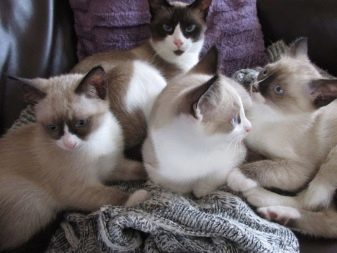
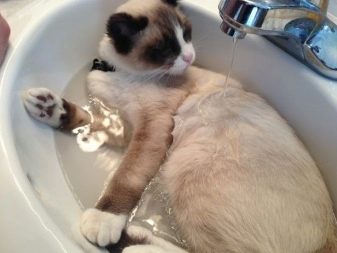
It is also noteworthy that the representatives of the breed are active, but unobtrusive. They will never demand attention to themselves, although they absolutely cannot stand loneliness and miss their masters. In games, they are delicate and do not allow themselves to scratch and bite household members. These animals do not offend children, but they love to be in the center of attention of one of the owners.
Unlike Siamese brethren, snow-shou does not harbor resentment if he was once offended. He will not shit in revenge, where it is impossible, as certain individuals of the cat family do. In addition, these cats do not emit heart-rending sounds: they like to talk, but their language is not so unpleasant and not harsh.
As for quick wits, you still need to look for such enterprising cats.... If they are planning to leave the room, they will deal with the handle and turn it as needed to open the door. And they also easily cope with one-handed taps if they suddenly need water. And if the cat likes some small thing, he can pick it up and hide it in a secluded place.

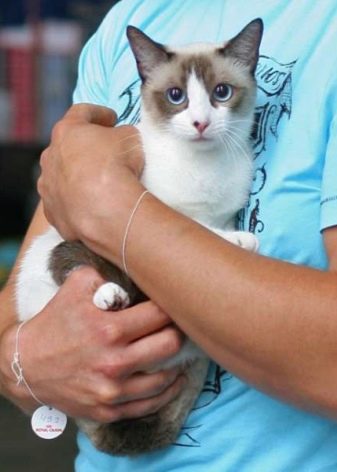
Content
Snow cats are amazing pets, they cannot live in outdoor conditions and require special treatment. Before adopting such a pet, the breeder should know that the Snow Shus have inherited a predisposition to certain diseases from related breeds. Some individuals may be born with tail defects or even squint. In addition, due to inadequate care, pets can often get sick. You cannot have a kitten in a house where the owners are not at home for a long time. Snow cats refuse to spend time alone, they can complain to their owner about their loneliness in a sad voice.
As for the choice of a kitten in the cattery, a representative of a high-quality breed has a white corner on the face in the shape of the letter V. The kitten's eyes should be blue.
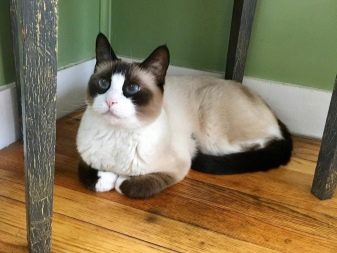
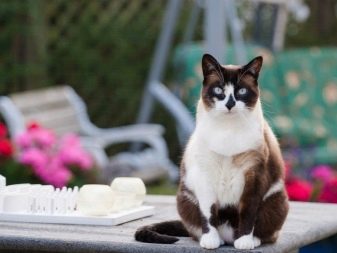

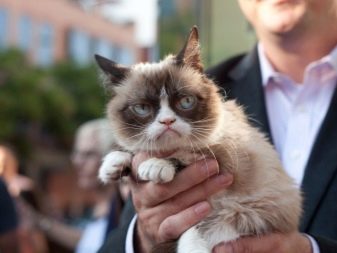
Kid's choice
It is necessary to choose a kitten in the cattery personally, paying attention to the external data, behavior, the presence of a passport and pedigree, as well as breed characteristics. Good maintenance in the nursery will be indicated by the neatness of the baby, his activity and the absence of parasites. His eyes will be clear, the mucous membrane of the mouth - pinkish and smooth. Habits will tell about the demeanor: if the kitten was raised correctly, it will not hiss, bite and scratch. You need to choose an active and sociable kitten, distinguished by a restless character and cheerfulness. The documents must contain the marks of the veterinarian, his signature, the stamp of the veterinarian and a holographic sticker.
It is important to pay attention to the signs of the breed, the main of which, regardless of age, will be a stocky body, blue (less often gray-blue) eyes and a thick neck.

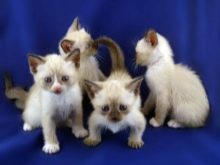
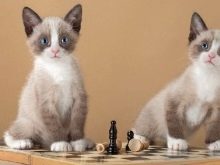
Adaptation and litter training
After the kitten is brought home, stress levels need to be reduced. The kitten is protected from unnecessary noise and screaming. They immediately buy him his own bed, put a bowl of food and water. Place a tray nearby. Given that kittens are naturally curious, the owners try to remove fragile objects and, if possible, wires away.
As for the litter box, the kitten very quickly understands where to go to the toilet. In theory, when the baby is taken from the receiver, he is already accustomed to the tray. But if suddenly trouble happens, it is enough to remove everything with a napkin and put it in the tray, placing the pet itself in it. As a rule, he quickly understands what this place is for. The filler for the tray can be selected according to the age of the baby. The children's option is convenient in that it does not stick to the paws, therefore it does not spread throughout the home.
As the kitten grows up, you can also replace the filler, choosing options in the form of granules of a larger fraction. The type of tray can be different, but the kitten does not need a closed view.
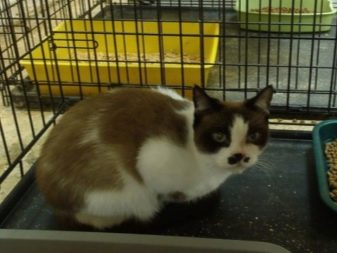
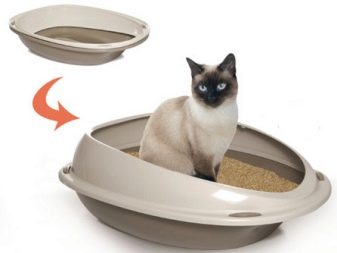
Hygiene
Like any other pet, the snow shoo needs timely hygiene of the ears, eyes and claws.The coat should be brushed at least once a week. This will bring pleasure to the pet and save the house from small hairs, which is especially important during molting. During this period, it is necessary to deal with the pet's fur more often (you can do it twice a week). Despite the fact that the hair of cats of this breed does not get tangled, the cat should have its own comb with natural bristles. Someone buys massage mittens with soft silicone teeth for smooth-haired cats. Combing is convenient not only because you can rid your pet of dead hairs. In addition, it allows the protective layer of natural fat to be evenly distributed over the coat.
In the absence of time, you can buy a brush for mounting on the wall and fix it at the bottom so that the pet can independently come up and comb his fur on it. Some cats like it very much, they rub with pleasure against such brushes.
There is no need for daily brushing of the coat, despite the fact that it is quite dense and thick. However, cats adore grooming, so from time to time you can pamper your pets with a similar procedure.

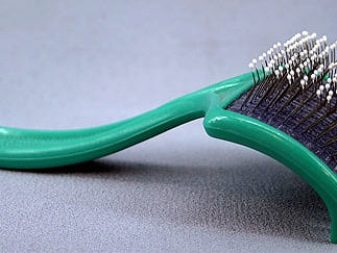
Ears and eyes should be cleaned as they become dirty. They are cleaned about once a week with a damp cloth dipped in chamomile broth. Someone uses a cotton pad and ordinary warm water for this. The eyes of the animal can be treated with a similar decoction at least once a week. You need to bathe your pet no more than once a month.
If suddenly the animal began to pull at its ears, then, most likely, parasites have appeared in them, which must be got rid of with the help of drugs... The type of medicine and the frequency of its use will be determined by the doctor. At the first sign of scratching, take the animal to the veterinarian. It is impossible to start the course of the disease: it does not go away on its own.
For claws, you need to purchase a scratching post, and there may be several such accessories in the house... They are placed near the front door and in the places of the greatest attention of the pet. This will protect the upholstery of upholstered furniture and wallpaper from destruction. As needed, claws should be trimmed with scissors or special forceps, cutting off the transparent end of each nail.
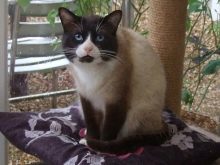
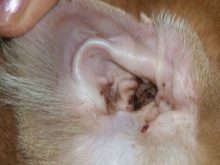
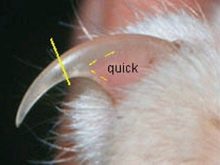
It is also important to monitor the condition of your pet's teeth, because tartar can be deposited in them. Of course, not every owner will clean them for his cat, but if suddenly at least one tooth falls out, this will require an immediate visit to a specialist. In addition, periodontal disease may occur in some cats.
In order to prevent such problems, the cat needs timely preventive examinations and cleaning according to all the rules that a veterinarian can carry out. In addition, you need to try to brush the animal's teeth with a special toothpaste and a tiny toothbrush, as well as use special treats for cleaning teeth.
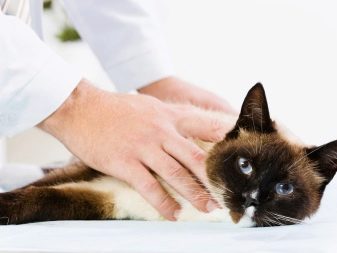
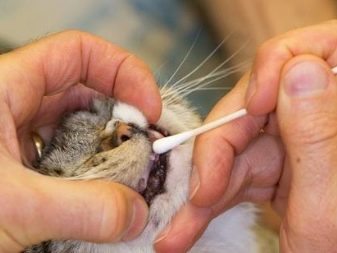
Walking
No matter how domestic an animal is, it weakens without fresh air. It is necessary to systematically and every day walk with him on the street. At first, it can be a walk with a kitten in your arms, over time, its duration can be increased. At the same time, the cat will not mind if a harness flaunts on his neck. After a walk, which is unlikely to do without researching objects and plants, it is necessary to examine the teddy cat for the presence of parasites (ticks or fleas).
For prevention purposes, you can use an antiparasitic collar, the action of which lasts on average about one month. Further, it is replaced with a new one. To check the coat, you can purchase a special comb with fine and fine teeth.
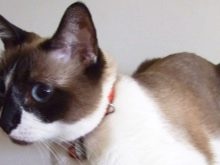
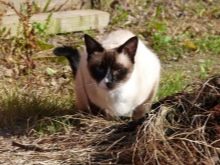
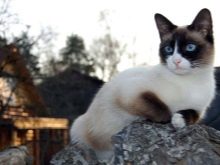
Games
These cats are highly trainable, but it is necessary to start raising them as early as possible. You cannot shout at them: they understand the intonation of the voice and catch the mood. If for some reason they commit a misdemeanor and hide, then in order to lure them out of the shelter, it is enough to open the tap with water, because snow-shu are not indifferent to it. To prevent the cat from stealing small objects, it is necessary to provide him with his toys, which he will constantly carry in his teeth, like prey.
In the game, it is not worth using arms or legs, but special toys for cats. This will eliminate the likelihood of bites and scratches, as well as accustom the pet to its own things.
These can be different items, but not the things that the owner uses. For example, you do not need to play with a trouser strap, because the cat will consider it his own, so he can steal and hide.
Try to find time to play with your cat. This will strengthen her bond with her owner, increase her loyalty and show her concern. Ideally, it is enough to play with her twice a day, finding 15 minutes in the morning and evening for this.
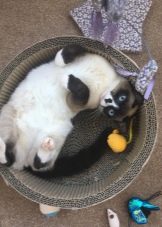

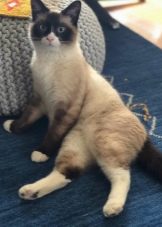
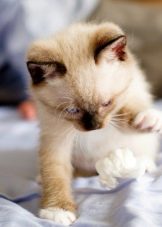
Periodically, you can call the cat for games or simple communication. The pet will be glad to have a "conversation" too, because he perfectly understands when he is being praised, so he will not refuse to be treated kindly by his owner.
Upbringing
To prevent the cat from growing wild and harsh, the atmosphere in the house should be calm. An active cat grows up in a house where there is no screaming or assault. Its punishment can be the stern voice of the owner, but it is useless to drag the guilty animal by the withers or poke its muzzle. From this, it simply loses confidence and tries to be away from everyone, which is usually unusual for her.
It is important to provide the kitten with its own bed and playground.... He should have his own bowl of food and water. The house should have certain rules and a regime to which all household members obey. Seeing this, the pet itself adjusts to the existing rules. Where the owners have no order, there is no point in looking for it in the animal. It should not beg for food or attention, it is all part of the upbringing and responsibility of the person.
You can't put a kitten to sleep with you in the same bed.... This erases the boundaries of his understanding of the place, he perceives himself as equal to the owner, which in the future can develop into problems of upbringing and the need to correct behavior. The animal must know the resting place, which is its bed.


If you wish, you can buy him an additional house or even a hammock for a battery, where he will be warm and comfortable.
What to feed?
The key to a cat's health is its weight. Of course, she should not be overfed or, on the contrary, too thin. Everything is good in moderation, so it is important to choose the right diet. For example, you cannot feed an animal with industrial feed alone. Despite the assurances of the manufacturers of its exceptional benefits, it cannot provide the pet with all the necessary vitamins and nutrients.
The cat's diet should be balanced. From time to time, you can add variety to it with wet food. But the diet should also contain natural food. For example, a cat should receive fish and lean meat, as well as special herb for cats. Occasionally, it is necessary to give your pet egg yolks, as well as fermented milk products (with the exception of cream and sour cream).
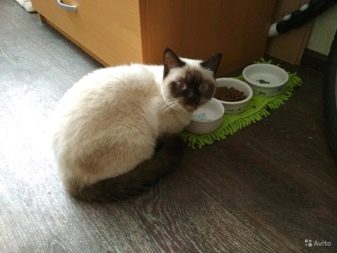

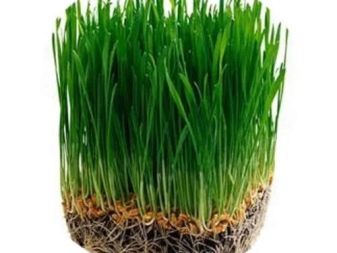
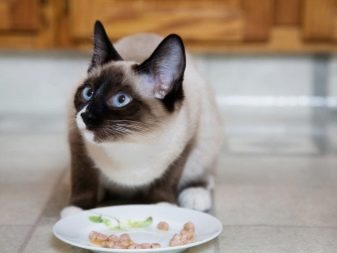
Kefir, fermented baked milk and yogurt may be included in the diet. In addition, raw oatmeal can be added to the main meal. Some types of fruits and vegetables, which can be boiled or raw, are healthy food for your cat. In order to cleanse the stomach of wool lumps (when licking the hair by the cat itself), you can give the pet sprouts of wheat or oats. Meat or fish should be given to the cat in a boiled form. In addition to them, from time to time he will have to give special vitamin complexes, observing the dosage indicated by the specialist.
Choice of food should be based on the age of the cat. When choosing it, it is necessary to pay attention to both the type of wool and health features. When choosing natural foods, it is important to ensure that there are no artificial additives in the foods. Wherein small kittens are fed more often, as they grow older, the frequency is reduced, increasing the volume of each portion... Kittens are usually fed no more than six times a day. A 2-year-old cat does not need to be fed more than twice a day. Food can be given to him at certain hours in the morning and in the evening.
You cannot feed your cat food from your table. You can not feed her stale food and monotonous food. For example, the same meat can be different (it can be beef, turkey, chicken).

In addition, you can give your pet offal (chicken stomachs, hearts, wings). Of the vegetables, carrots, cucumbers, tomatoes and even cabbage must be present in the diet. Cereals (buckwheat, rice, semolina and rolled oats) will also be useful.
Water for your cat should always be clean and fresh. Food bowls can be either ceramic or metal. Plastic products are much worse, because they quickly become covered with scratches, in which colonies of bacteria can settle over time. In addition, plastic cannot be called a completely harmless material, because some of its varieties emit harmful substances into the air during operation.
Some snow shou products may not be given. For example, the list of unauthorized products includes pork and river fish, milk and potatoes, spices, salinity and smoked meats.
You cannot treat "snow white" to sausages and sausages. In addition, it is categorically contraindicated to feed pussies with sweets, which can harm teeth and provoke allergic reactions.
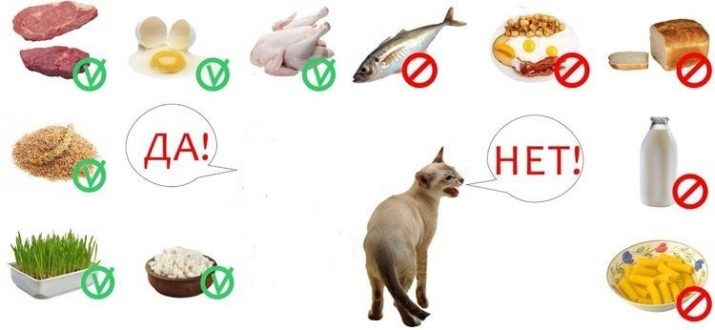
Vaccination
As a rule, when a kitten is taken from the cattery, it is vaccinated. However, throughout his life he cannot do without the necessary vaccinations. They are performed according to the usual schedule, inoculating comprehensively in early childhood and repeating the necessary vaccinations every year. An individual schedule can be assigned only in individual cases. It is worth considering: there are periods when the introduction of the vaccine is unacceptable. For example, this should not be done when babies' teeth are changing (usually between four and eight months old). In addition, pregnant cats and immunocompromised individuals should not be vaccinated.
As for the nuances of vaccinations, then about 10 days before the introduction of the vaccine, the pet is given an anthelmintic.
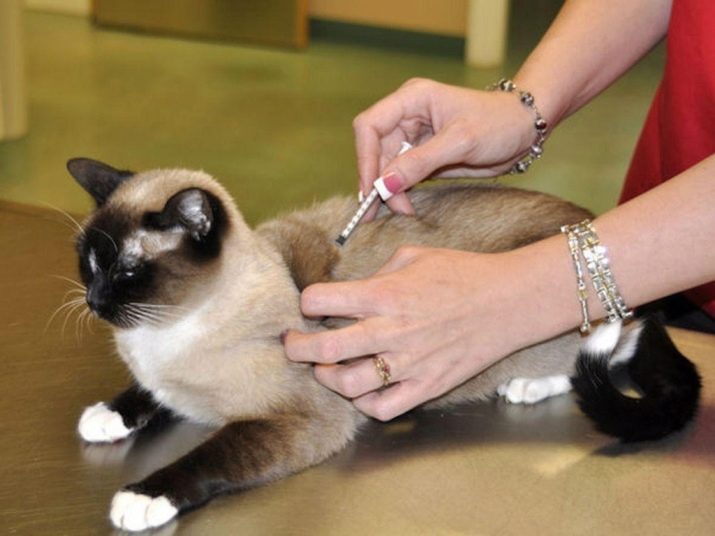
Breeding
Mating cats is carried out according to the standard scheme. At the same time, mating does not cause difficulties: it is much more important to get kittens close to the standard, because half of the litter is far from it. As a rule, the first estrus in cats occurs before the age of one year. However, like the second one, it should be skipped. Experts recommend mating when the cat is about a year and a half.... It is advisable to select a pair in the same cattery where the kitten itself was chosen. Doubtful individuals are not suitable for mating, as this leads to the degeneration of the breed and various diseases of kittens born in this mating.
An ideal mating partner should be purebred, well-groomed, neat. In addition, this individual must have a pedigree, he must be vaccinated and healthy. Someone pays attention to the color criteria and even to the length of the so-called socks: if a cat has them long, then the cat should be small and vice versa.
An unspoken rule when mating is the fact that often one kitten from a litter is taken by the owner of the cat. This nuance must be discussed in advance. Sometimes, instead of an individual, the owner of the "groom" is paid the cost of the baby.

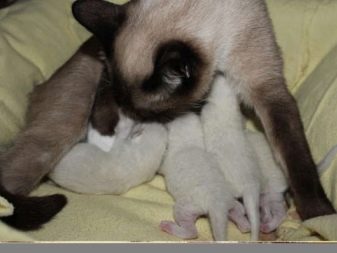
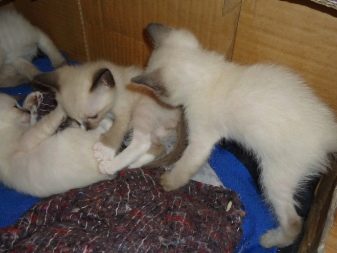
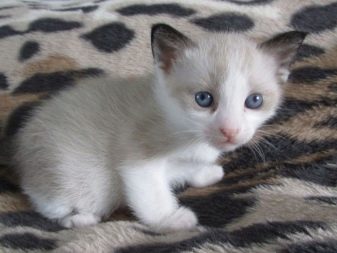
As for the frequency of mating, breeders believe that it is enough for a cat to give birth no more than once a year.... This may be due to the state of her health and the degree of depletion of the body (the more often the birth, the less energy for the subsequent bearing of kittens). After the birth of the babies, the first three months of her strength will go to feeding. She can bring from three to seven babies at a time. If mating is done frequently, the cat will get sick.
Her body will be susceptible to various infectious diseases.She herself will not only lose weight, but also change externally. Its coat will become dull and its appearance painful and weak. In addition, frequent childbirth will affect the life expectancy of the animal: such a cat will not live long. Despite the fact that kittens are expensive, this nuance should not harm the health of the mother-cat.
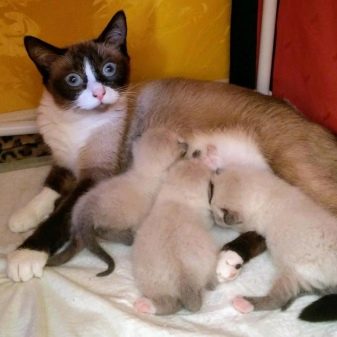
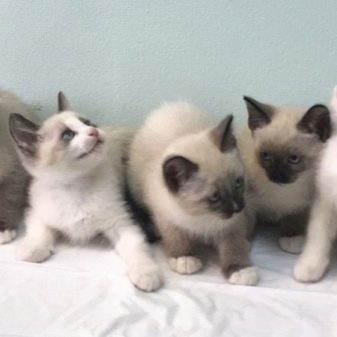
When there is estrus, but mating does not work, this indicates a malfunction of the body. Abstinence can cause serious diseases of the reproductive system. In general, a cat's childbirth proceeds without complications, although most kittens are born with a hooked tail. The cost of a kitten can be up to 15,000 rubles. Purebred individuals with ideal coloration are more expensive: the price of such kittens ranges from 30,000 to 80,000 rubles or more. However, the partner must himself be not only purebred, but fit into the established standard.
If the owner does not plan to breed kittens, the pet is castrated or spayed.
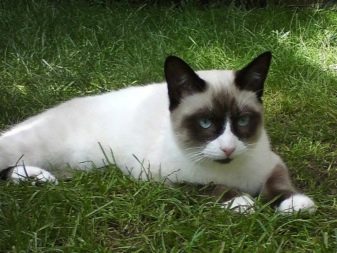
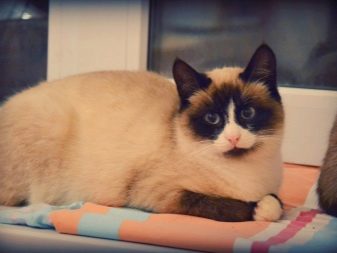
Read more about the snow-shoo cat breed in the next video.

































We'll take snow shu.